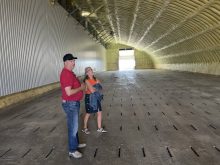PENTICTON, B.C. — Young children are more likely to be hurt in car accidents than on the playground, said an early childhood researcher.
Beverlie Dietz, director of learning and applied research at Okanagan College, said outdoor play should be a part of everyday life, whether at home or in child-care centres.
Her study of early childhood educators found few had intensive training in outdoor play curriculum, which correlates directly with why children’s outdoor experiences are waning compared to their indoor ones.
“Outdoors, children acquire social, emotional, cognitive and physical skills. Indoors, they are more focused on cognitive development,” said Dietz.
Read Also

Sustainable food has ‘lost all meaning’: prof
That marketing strategy is deader than a doornail, says a University of Guelph professor who specializes in consumer preferences and perceptions of agriculture and food.
She offered tips for encouraging outdoor play at a recent parenting conference in Penticton, B.C.
She said tasks such as building sand castles are a foundation for problem solving and tackling mathematics and science in the school years.
Dietz called that cycle of curiosity a useful part of problem solving and discovery for young children.
“It really is the formation of critical thinking.”
She said parents need to loosen the reins to let children experiment and take risks, such as climbing trees, making snowballs and having rough and tumble play.
“If adults stop them, they’ll find a way to deal with that innate need,” she said.
“The more we take out and make play sterile, the more bullying we’re going to have because kids aren’t developing self-regulation skills or necessary skills to know how far they can push another.”
There are also health benefits.
Dietz cited studies showing children on farms and in rural areas who generally have more outdoor playtime pick up fewer viruses.
“Viruses are spread indoors, not outdoors,” she said.
Even in the colder prairie climate, children can be outside for play if appropriately dressed and kept active and stimulated, she said.
It doesn’t have to be expensive and works best when interacting with the natural world and fostering their natural curiosity.
“Children who are curious read more, make more friends, have a better vocabulary,” she said.















